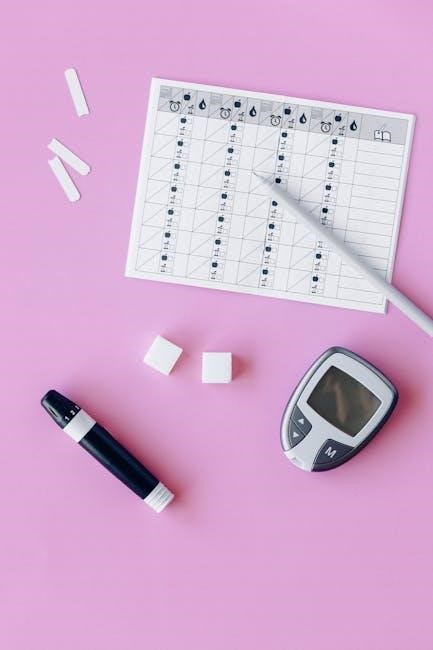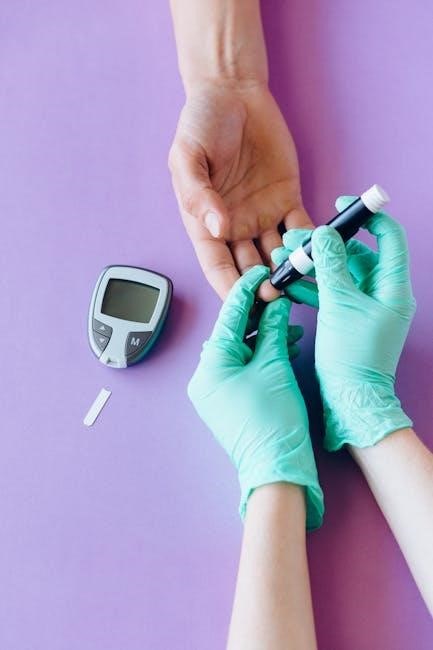A blood sugar log sheet is a tool for tracking glucose levels, helping individuals manage diabetes by monitoring trends and understanding the impact of diet and exercise.
1.1 What is a Blood Sugar Log Sheet?
A blood sugar log sheet is a tool used to record and monitor glucose levels, providing a clear overview of daily blood sugar fluctuations. It typically includes columns for the date, time, glucose readings, and notes on meals, medications, or physical activity. This document helps individuals with diabetes track their condition, identify patterns, and make informed decisions about their diet, exercise, and treatment. By maintaining a log, users can better understand how different factors affect their blood sugar levels, enabling more effective management of their condition. Regular logging also aids healthcare providers in assessing progress and adjusting treatment plans as needed. It is a simple yet essential resource for diabetes care.
1.2 Importance of Tracking Blood Sugar Levels
Tracking blood sugar levels is crucial for managing diabetes effectively. It helps individuals understand how diet, exercise, and medications impact their glucose levels, enabling better decision-making. Regular monitoring prevents hyperglycemia and hypoglycemia, reducing the risk of complications like nerve damage or vision problems. By identifying patterns, users can adjust their lifestyle choices to maintain stable blood sugar levels. This data also assists healthcare providers in refining treatment plans, ensuring personalized care. Consistent tracking fosters accountability and empowers individuals to take control of their health. Over time, it becomes a vital tool for achieving long-term glucose control and improving overall well-being. Accurate records are essential for effective diabetes management and preventing potential health crises.

Structure and Components of a Blood Sugar Log Sheet
A blood sugar log sheet typically includes date, time, blood sugar levels, meals consumed, medications taken, and notes for tracking glucose trends and managing diabetes effectively.
2.1 Key Components of a Blood Sugar Log
A blood sugar log typically includes essential details such as the date, time, and measured blood glucose levels. It also records meals consumed, portions, and medications taken, along with any physical activity or notable events. Some logs may include space for additional notes, such as symptoms experienced or unusual patterns observed. These components help individuals and healthcare providers identify trends, understand how different factors influence blood sugar levels, and make informed decisions for diabetes management. Accurate and consistent logging ensures comprehensive tracking, enabling better control over glucose fluctuations and overall health outcomes. By capturing a complete picture of daily habits and their effects, a blood sugar log becomes a vital tool for effective diabetes care.
2.2 How to Read and Interpret Blood Sugar Data
Reading and interpreting blood sugar data involves analyzing the recorded glucose levels to identify patterns and trends. By reviewing the log, individuals can determine if their levels are within target ranges, too high (hyperglycemia), or too low (hypoglycemia). Noting the timing of measurements—such as before or after meals—helps assess how diet and activities impact glucose levels. Consistently high or low readings may indicate the need for adjustments in medication, diet, or exercise routines. Over time, this data can reveal how different factors, like stress or illness, affect blood sugar, enabling more personalized and effective diabetes management strategies. Accurate interpretation is crucial for maintaining optimal health and preventing complications.
2.3 Tips for Accurate Blood Sugar Logging
Accurate blood sugar logging requires consistency and attention to detail. Always use a reliable glucometer and record readings immediately to avoid memory errors. Note the exact time of each measurement, as timing affects glucose levels. Document any factors that may influence readings, such as meals, physical activity, or stress. Be consistent in how you log data, using clear and legible handwriting or digital inputs. Regularly review your log to identify patterns or discrepancies. Double-check entries for accuracy and completeness. Consider setting reminders to ensure logging becomes a habit. Finally, share your log with healthcare providers to gain insights and adjust your management plan effectively. These practices ensure reliable data for better diabetes control.

Benefits of Using a Blood Sugar Log Sheet
Using a blood sugar log sheet improves glucose control, enhances treatment decisions, and boosts accountability. It helps identify patterns, optimizes medication, and supports long-term health goals effectively.
3.1 Health Benefits of Blood Sugar Monitoring
Monitoring blood sugar levels provides valuable insights into glucose trends, enabling better diabetes management. Regular tracking helps prevent complications like neuropathy and retinopathy by maintaining stable levels. It allows for timely adjustments to medication, diet, and exercise, promoting overall health. Consistent monitoring also enhances understanding of how different foods and activities impact glucose, fostering informed decision-making. By identifying patterns, individuals can avoid severe highs and lows, reducing the risk of emergencies. This proactive approach supports long-term glycemic control, improving quality of life and reducing diabetes-related risks. Accurate logging further aids healthcare providers in tailoring treatments, ensuring personalized care. Ultimately, blood sugar monitoring is crucial for achieving and sustaining optimal health outcomes.
3.2 Practical Advantages of Using a Log Sheet

Using a blood sugar log sheet offers numerous practical benefits, enhancing daily diabetes management. It provides a clear, organized record of glucose levels, making it easier to track progress over time. The log sheet helps identify trends and patterns, enabling individuals to make informed decisions about diet, exercise, and medication. It also serves as a valuable tool for healthcare providers, offering insights that guide personalized treatment plans. Additionally, logging blood sugar levels promotes accountability and consistency, which are crucial for effective glycemic control. The structured format of a log sheet ensures that no important details are overlooked, making it an indispensable resource for managing diabetes efficiently and improving overall health outcomes.
3.3 Psychological Impact of Consistent Logging
Consistent use of a blood sugar log sheet can have a profound psychological impact, fostering a sense of control and empowerment in managing diabetes. By regularly tracking glucose levels, individuals gain clarity and confidence in their ability to influence their health outcomes. This routine can reduce anxiety and uncertainty, as it provides a clear understanding of how lifestyle choices affect blood sugar. Over time, consistent logging can also enhance motivation, as individuals see progress and the tangible results of their efforts. This sense of accomplishment can improve overall well-being and resilience, making the daily challenges of diabetes management feel more manageable and less overwhelming.

How to Use a Blood Sugar Log Sheet Effectively
Record blood sugar levels at specific times, such as fasting, before/after meals, and include notes on diet, exercise, and medication for better glucose management and trend analysis.
4.1 When and How to Record Blood Sugar Levels
Record blood sugar levels at consistent times, such as fasting (before breakfast) and 2 hours after meals, to monitor glucose trends. Use a glucometer for accurate readings, noting the date, time, and glucose value. Include additional details like diet, physical activity, and medication doses to identify patterns. Consistency is key for reliable data analysis. Regular logging helps track how different factors affect blood sugar, enabling informed adjustments to diet or treatment plans. Reviewing logs with healthcare providers can also guide personalized management strategies and improve overall diabetes care.
4.2 How to Identify Trends and Patterns
Identifying trends and patterns in blood sugar levels involves regularly reviewing your log to spot recurring high or low glucose readings. Look for consistent spikes or dips at specific times of the day, such as after meals or during fasting periods. Correlate these patterns with factors like diet, physical activity, and medication to understand their impact. For example, frequent high readings after dinner may indicate a need to adjust evening meals or insulin doses. Consistency in logging is crucial for accurate trend analysis. By identifying these patterns, you can make informed adjustments to your diabetes management plan and improve glycemic control over time.
4.3 Setting Goals for Blood Sugar Management
Setting realistic and measurable goals is essential for effective blood sugar management. Start by defining target glucose ranges in consultation with your healthcare provider. These goals should be specific, achievable, and aligned with your overall health objectives. Regularly review your blood sugar log to track progress and identify areas for improvement. Celebrate milestones, such as maintaining consistent readings within your target range, to stay motivated. Adjust your goals as needed based on lifestyle changes, medication adjustments, or shifts in health status. By setting clear objectives and monitoring your progress, you can better manage your blood sugar levels and improve your overall well-being over time.

Customizing Your Blood Sugar Log Sheet
Personalize your log sheet by adding notes, medication details, or additional health metrics to tailor it to your specific needs and improve blood sugar management effectively.
5.1 Tailoring the Log to Your Needs
Tailoring your blood sugar log sheet to your specific needs ensures it becomes a personalized tool for effective glucose management. By adding sections for carbohydrates, exercise, or medication, you can track factors influencing your levels. Customizing allows you to focus on what matters most, whether it’s monitoring fasting glucose or post-meal spikes. Incorporating notes about meals, stress, or physical activity provides context for fluctuations. This personalized approach helps identify patterns and makes it easier to adjust your lifestyle or treatment plan. A tailored log sheet not only enhances accuracy but also empowers you to make informed decisions, leading to better blood sugar control and improved overall health outcomes.
5.2 Incorporating Additional Health Metrics
Incorporating additional health metrics into your blood sugar log sheet enhances its effectiveness by providing a holistic view of your health. Metrics such as blood pressure, weight, and medication dosage can offer insights into how these factors influence glucose levels. Adding sections for physical activity, sleep quality, or stress levels helps identify correlations between lifestyle and blood sugar fluctuations. This comprehensive approach allows for better pattern recognition and informed decision-making. For example, tracking carbohydrate intake alongside blood sugar levels can reveal how different foods impact your glucose. By integrating these metrics, you create a personalized dashboard that supports overall health management and helps you achieve your diabetes management goals more effectively.
5.3 Best Practices for Customization
Customizing your blood sugar log sheet effectively involves tailoring it to your specific needs while maintaining clarity and functionality. Start by identifying the metrics most relevant to your health goals, such as glucose levels, medication doses, or physical activity. Use clear headings and organize the layout to avoid clutter. Consider adding color-coding or symbols to highlight important trends or anomalies. Digital tools often allow for easy customization, but even paper-based logs can be personalized with stickers or annotations. Regularly review and update your log sheet to ensure it remains relevant and useful. By standardizing your entries and keeping the design intuitive, you can maximize the benefits of tracking your health metrics and make informed decisions for better diabetes management.

Digital vs. Traditional Blood Sugar Log Sheets
Digital log sheets offer convenience, automation, and data analysis, while traditional paper-based logs provide simplicity and accessibility without technology, catering to different user preferences and needs effectively.
6.1 Pros and Cons of Digital Log Sheets
Digital blood sugar log sheets offer real-time tracking, automated data analysis, and reminders, enhancing accuracy and convenience. They also enable easy sharing with healthcare providers and long-term data storage. However, they require a smartphone or device, posing a barrier for those uncomfortable with technology. Privacy concerns and potential technical issues, like app glitches or data loss, are additional drawbacks. Despite these challenges, digital logs are preferred for their comprehensive insights and accessibility, making them a valuable tool for modern diabetes management. Balancing these pros and cons helps individuals choose the most suitable option for their lifestyle and needs.
6.2 Pros and Cons of Paper-Based Log Sheets
Paper-based blood sugar log sheets provide a simple, low-cost method for tracking glucose levels without requiring technology. They are accessible to everyone, including those who prefer traditional methods or have limited digital access. However, paper logs are prone to errors, loss, or damage, which can disrupt monitoring. They also lack automation, requiring manual data entry and analysis, which can be time-consuming. Despite these drawbacks, many find paper logs satisfying for their tactile nature and ease of use. They remain a reliable option for individuals who value simplicity and portability, making them a viable choice alongside digital tools in diabetes management.
6.3 Choosing the Right Format for You
Selecting the right blood sugar log format depends on personal preferences, lifestyle, and specific needs. Digital tools offer convenience, automation, and data analysis, ideal for tech-savvy users who want real-time insights. Paper-based logs are better for those who prefer a hands-on approach or have limited digital access. Consider factors like ease of use, portability, and the ability to track additional metrics such as diet or exercise. Some users opt for a hybrid approach, combining both formats for flexibility. Ultimately, the choice should align with individual habits and goals to ensure consistent and effective blood sugar monitoring. This decision is crucial for maintaining long-term health and managing diabetes efficiently.
The Role of Blood Sugar Log Sheets in Diabetes Management
Blood sugar log sheets are essential for diabetes management, helping track glucose levels, identify patterns, and support informed treatment decisions to maintain optimal health and prevent complications.
7.1 Managing Blood Sugar Levels Daily
Managing blood sugar levels daily is crucial for individuals with diabetes. A blood sugar log sheet helps track glucose readings, allowing for timely adjustments to diet, exercise, and medication. By recording levels at specific times, such as before meals or after physical activity, individuals can identify patterns and make informed decisions. This daily monitoring also enables early detection of hyperglycemia or hypoglycemia, preventing potential complications. Consistent logging fosters accountability and helps maintain target blood sugar ranges, promoting overall health and well-being. Over time, this data becomes invaluable for refining treatment plans and achieving long-term glucose control.
7.2 Using Log Sheets During Illness or Stress
During illness or stress, blood sugar levels can fluctuate significantly, making consistent logging crucial. A blood sugar log sheet helps track these changes, enabling individuals to adjust their treatment plans accordingly. Illnesses often cause hyperglycemia due to increased stress hormones and inflammation, while stress can also raise glucose levels. By monitoring levels more frequently, individuals can identify patterns and prevent complications. Logging during these periods provides valuable insights for healthcare providers, helping them tailor treatments. Additionally, it allows for timely adjustments to medication, diet, or exercise routines. Consistent tracking during illness or stress ensures better control and supports overall diabetes management, aligning with medical recommendations for monitoring.
7.3 Integrating Log Sheets into Your Treatment Plan
Integrating blood sugar log sheets into your treatment plan enhances diabetes management by providing actionable data for healthcare providers. These logs serve as a bridge between daily glucose monitoring and medical decision-making. By sharing detailed records, individuals enable their healthcare team to assess trends, identify potential issues, and adjust medications or therapies. Logs also help in tailoring meal plans and exercise routines, ensuring personalized care. Regularly updated logs can prevent complications by highlighting patterns that may require intervention. This collaborative approach fosters better communication and trust between patients and providers, leading to more effective and targeted treatment strategies. Consistent logging ensures that no critical data is overlooked, supporting long-term health goals and improved outcomes.

Monitoring and Analyzing Blood Sugar Patterns
Monitoring blood sugar patterns helps identify trends, understand glucose fluctuations, and refine treatment plans, ensuring better diabetes management through consistent and accurate logging of glucose levels over time.

8.1 Identifying Patterns in Blood Sugar Levels
Identifying patterns in blood sugar levels is crucial for effective diabetes management. By regularly tracking glucose data, individuals can detect trends, such as high morning readings or post-meal spikes. These patterns help pinpoint factors influencing blood sugar, like diet, exercise, or medication. Over time, this data enables personalized adjustments to lifestyle or treatment plans. For instance, consistent hyperglycemia may indicate a need for medication changes, while frequent hypoglycemia could signal overcorrection. Analyzing these trends with healthcare providers ensures tailored strategies for better glycemic control. Accurate logging and pattern recognition are key to achieving long-term blood sugar stability and overall health.
8.2 Adjusting Your Diet and Exercise Based on Logs
Tracking blood sugar levels helps identify how diet and exercise impact glucose readings. By analyzing logs, individuals can pinpoint which foods cause spikes or dips and adjust their meals accordingly. For example, high-carbohydrate foods may lead to elevated levels, prompting a switch to lower-glycemic options. Similarly, exercise timing and intensity can be refined to optimize blood sugar control. Logs reveal patterns, enabling tailored dietary plans and physical activity routines. This data-driven approach empowers individuals to make informed decisions, balancing nutrition and exercise for stable glucose levels. Regular monitoring ensures adjustments are effective and sustainable, promoting overall metabolic health and reducing diabetes-related risks.
8.3 Sharing Your Log with Healthcare Providers
Sharing your blood sugar log with healthcare providers is a vital tool for effective diabetes management. By reviewing your glucose trends, healthcare professionals can identify patterns, assess treatment efficacy, and make informed adjustments to your care plan. Logs provide concrete data, enabling providers to offer personalized dietary, exercise, and medication recommendations. This collaboration ensures tailored strategies to stabilize blood sugar levels and prevent complications. Regular sharing of logs also fosters open communication, allowing for timely interventions and improved health outcomes. Ultimately, integrating your blood sugar log into clinical decision-making enhances the quality of care and empowers both you and your healthcare team to work toward better glucose control and overall wellness.
Long-Term Value of Blood Sugar Log Sheets
Blood sugar log sheets provide long-term insights into glucose trends, aiding in sustained health management and informed decision-making for diabetes care and overall wellness.
9.1 Tracking Progress Over Time
Tracking progress over time with a blood sugar log sheet allows individuals to monitor glucose trends, identify patterns, and assess the effectiveness of their diabetes management plan. By consistently recording levels, users can observe how diet, exercise, and medications impact their blood sugar, enabling informed adjustments. Long-term tracking also reveals seasonal or lifestyle-related fluctuations, helping to refine strategies for better control. This data is invaluable for setting realistic health goals and maintaining motivation. Over time, the log sheet becomes a comprehensive record of achievements and challenges, fostering a deeper understanding of personal health dynamics and supporting sustained wellness efforts.
9.2 Using Logs for Long-Term Health Goals
Using blood sugar log sheets for long-term health goals empowers individuals to set realistic targets and track their progress. By analyzing trends over months or years, users can identify how lifestyle changes, medications, and treatments impact their glucose levels. This data helps in refining strategies to achieve and maintain optimal blood sugar control. Logs also serve as a motivational tool, showing improvements and reinforcing the importance of consistent management. Additionally, they provide a clear record for healthcare providers, enabling personalized adjustments to treatment plans. Over time, this detailed documentation supports better decision-making and helps prevent complications, making it an essential component of long-term diabetes care and overall wellness.
9.3 Maintaining Consistency in Logging
Maintaining consistency in blood sugar logging is crucial for effective diabetes management. Regular recording ensures accurate data collection, helping identify patterns and trends over time. Consistency fosters accountability and motivates individuals to adhere to their monitoring routines. By logging at the same times daily, users can better understand how meals, exercise, and medications impact their glucose levels. Over time, this habit supports informed decision-making and improves overall health outcomes. Additionally, consistent logging provides healthcare providers with reliable data to adjust treatment plans. Making blood sugar tracking a daily priority helps build a sustainable routine, ultimately enhancing long-term diabetes control and reducing the risk of complications.

Conclusion and Resources
Blood sugar log sheets are essential tools for effective diabetes management, offering insights into glucose trends and supporting informed decisions. Utilize templates from reputable sources for consistent tracking and better health outcomes.
10.1 Summary of Key Points
Blood sugar log sheets are essential tools for managing diabetes, providing a clear record of glucose levels, medication, and lifestyle factors. They help identify patterns, track progress, and inform treatment decisions. Regular logging improves awareness and control, enabling better health outcomes. By monitoring trends, individuals can adjust diets, exercise, and medications effectively. Consistency in logging is crucial for long-term management and sharing data with healthcare providers enhances personalized care. Customizable templates, available as PDFs, offer flexibility to suit individual needs. Ultimately, blood sugar log sheets empower individuals to take charge of their diabetes, fostering a proactive approach to health management and improving overall well-being.
10.2 Where to Find Blood Sugar Log Sheet Templates
Blood sugar log sheet templates are widely available online, offering convenience for individuals managing diabetes. Healthcare providers often supply these forms, while organizations like the American Diabetes Association provide downloadable resources. Websites such as Google Sheets, Microsoft Excel, and specialized health platforms offer customizable templates. Many templates are available in PDF format, making them easy to print and use. Online marketplaces like Etsy also offer designer templates for a personalized touch. Additionally, mobile apps and digital tools provide interactive versions for those preferring electronic logging. These resources ensure accessibility, allowing individuals to choose the format that best suits their needs for effective blood sugar tracking and management.
10.3 Final Thoughts on Effective Blood Sugar Management
Effective blood sugar management is a lifelong commitment that requires consistency, awareness, and personalized strategies. Utilizing a blood sugar log sheet is a cornerstone of this process, enabling individuals to track patterns, identify triggers, and make informed decisions. By regularly reviewing logged data, one can gain insights into how diet, exercise, and medications impact glucose levels. Sharing this information with healthcare providers ensures tailored advice and adjustments to treatment plans. Over time, consistent logging fosters a deeper understanding of one’s body, empowering better control and reducing complications. Celebrating small milestones, like maintaining target ranges, can motivate long-term adherence. Ultimately, combining log sheet data with lifestyle changes and medical guidance creates a comprehensive approach to managing blood sugar and improving overall health.



